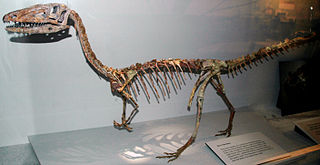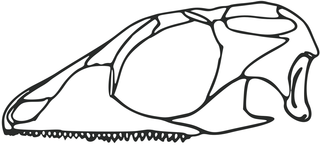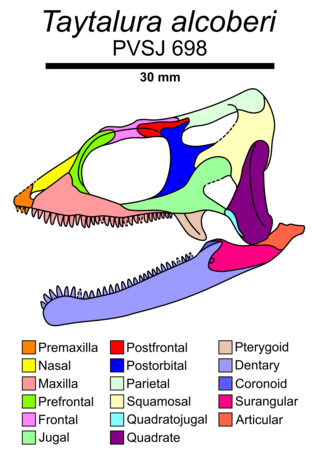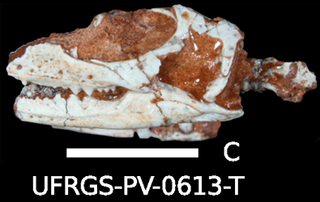Related Research Articles

Rhynchocephalia is an order of lizard-like reptiles that includes only one living species, the tuatara of New Zealand. Despite its current lack of diversity, during the Mesozoic rhynchocephalians were a speciose group with high morphological and ecological diversity. The oldest record of the group is dated to the Middle Triassic around 238 to 240 million years ago, and they had achieved a worldwide distribution by the Early Jurassic. Most rhynchocephalians belong to the group Sphenodontia ('wedge-teeth'). Their closest living relatives are lizards and snakes in the order Squamata, with the two orders being grouped together in the superorder Lepidosauria.

Coelophysis is a genus of coelophysid theropod dinosaur that lived approximately 215 to 208.5 million years ago during the Late Triassic period from the middle to late Norian age in what is now the southwestern United States. Megapnosaurus was once considered to be a species within this genus, but this interpretation has been challenged since 2017 and the genus Megapnosaurus is now considered valid.
Planocephalosaurus is an extinct genus of rhynchocephalian. Fossils of the genus were found in the Tecovas Formation of Texas and the Magnesian Conglomerate of England.

Eodicynodon is an extinct genus of dicynodont therapsids, a highly diverse group of herbivorous synapsids that were widespread during the middle-late Permian and early Triassic. As its name suggests, Eodicynodon is the oldest and most primitive dicynodont yet identified, ranging from the middle to late Permian and possessing a mix of ancestral Anomodont/therapsid features and derived dicynodont synapomorphies.
Redondasaurus is an extinct genus or subgenus of phytosaur from the Late Triassic of the southwestern United States. It was named by Hunt & Lucas in 1993, and contains two species, R. gregorii and R. bermani. It is the youngest and most evolutionarily-advanced of the phytosaurs.

Clevosaurus is an extinct genus of rhynchocephalian reptile from the Late Triassic and the Early Jurassic periods. Species of Clevosaurus were widespread across Pangaea, and have been found on all continents except Australia and Antarctica. Five species of Clevosaurus have been found in ancient fissure fill deposits in south-west England and Wales, alongside other sphenodontians, early mammals and dinosaurs. In regards to its Pangaean distribution, C. hadroprodon is the oldest record of a sphenodontian from Gondwana, though its affinity to Clevosaurus has been questioned.

Microposaurus is an extinct genus of trematosaurid temnospondyl. Fossils are known from the Cynognathus Assemblage Zone of the Beaufort Group in South Africa and the Rouse Hill Siltstone of Australia that date back to the Anisian stage of the Middle Triassic. These aquatic creatures were the short snouted lineage from Trematosaurinae.

Polonosuchus is a genus of rauisuchid known from the late Triassic of Poland. It was a huge predator about 5–6 metres in length and, like all rauisuchians, was equipped with a large head of long sharp teeth. The legs were placed almost underneath the body, unlike most reptiles, which would have made it quite fast and a powerful runner. The appearance was very similar to that of the more known Postosuchus, of North America, and shared with the latter the ecological niche of the apex predator.

Diphydontosaurus is an extinct genus of small rhynchocephalian reptile from the Late Triassic of Europe. It is the most primitive known member of Sphenodontia.

Gephyrosaurus is a genus of early rhynchocephalian first described and named in 1980 by Susan E. Evans. They are distantly related to the extant Sphenodon with which they shared a number of skeletal features including a large tooth row along the side of the palatine bone and posterior process of the dentary bone. The type species, G. bridensis, lived during Early Jurassic in Wales, UK. Whiteside & Duffin (2017) described the second species, G. evansae, known from a partial maxilla recovered from Late Triassic (Rhaetian) fissure fills in Carboniferous Limestone in Somerset. Gephyrosaurus, other potential gephyrosaurids and Wirtembergia are the only rhynchocephalians to lie outside Sphenodontia in modern definitions of the group, and have been found to be more closely related to squamates in some phylogenetic analyses.
Cargninia is an extinct genus of basal lepidosauromorph from the Late Triassic of Brazil. The type and only known species is Cargninia enigmatica. It is known from the holotype UFRGS PV 1027 T, a partial left dentary found in what is now Faxinal do Soturno, Rio Grande do Sul, southern Brazil, in the geopark Paleorrota. This locality is from the middle section of the Norian-age Caturrita Formation. Cargninia was named by José Fernando Bonaparte, César Leandro Schultz, Marina Bento Soares and Agustín G. Martinelli in 2010. The generic name honors Daniel Cargnin, a Brazilian priest and fossil collector, and the specific name means “enigmatic”, in reference to its uncertain phylogenetic placement.

Daemonosaurus is an extinct genus of possible theropod dinosaur from the Late Triassic of New Mexico. The only known fossil is a skull and neck fragments from deposits of the latest Triassic Chinle Formation at Ghost Ranch. Daemonosaurus was an unusual dinosaur with a short skull and large, fang-like teeth. It lived alongside early neotheropods such as Coelophysis, which would have been among the most common dinosaurs by the end of the Triassic. However, Daemonosaurus retains several plesiomorphic ("primitive") traits of the snout, and it likely lies outside the clade Neotheropoda. It may be considered a late-surviving basal theropod or non-theropod basal saurischian, possibly allied to other early predatory dinosaurs such as herrerasaurids or Tawa.
Bharatagama is an extinct genus of lepidosaur from the Early Jurassic of India. It has been suggested to be one of the oldest known lizards and the oldest known iguanian. The type and only species is Bharatagama rebbanensis, named in 2002. Over one hundred fossils of Bharatagama have been found in the Kota Formation, which outcrops in the Pranhita–Godavari Basin and dates back to about 190 million years ago (Ma). Despite its abundance, Bharatagama is known only from isolated jaw bones mixed together in microvertebrate assemblages with equally fragmentary remains of fish, sphenodontians, dinosaurs, crocodylomorphs, and mammals. These fossils represent all stages of development, from hatchlings to adults. The total length of the skull in adult specimens is estimated to have been about 15 millimetres (0.59 in). Later analysis suggested that the taxon might be a member of Rhynchocephalia.

Opisthodontia is a proposed clade of sphenodontian reptiles, uniting Opisthias from the Late Jurassic-earliest Cretaceous of Europe and North America with the Eilenodontinae, a group of herbivorous sphenodontians known from the Late Triassic to Late Cretaceous.

Clevosaurs are an extinct group of rhynchocephalian reptiles from the Triassic and Jurassic periods.

Sapheosaurs are an extinct group of rhynchocephalian reptiles from the Late Jurassic period. "Sapheosaurs" is an informal name for a group of rhynchocephalians closely related to the genus Sapheosaurus. It was first recognized as a group containing multiple genera by Hoffstetter in 1955. The group has sometimes been given a formal taxonomic name as the family Sapheosauridae, although in some analyses this group belongs to the family Sphenodontidae and thus cannot be assigned its own family. They were fairly advanced rhynchocephalians which may have had semiaquatic habits.
Fraxinisaura is an extinct genus of basal lepidosauromorph reptile known from the Middle Triassic of Germany. The only known species is Fraxinisaura rozynekae. It possessed an elongated snout, unique features of the teeth, and an ilium which was intermediate in orientation between sphenodontians and squamates. Based on characteristics of the maxilla, it is considered a close relative of Marmoretta from the Middle Jurassic of the United Kingdom, resolving a ghost lineage between that genus and other Triassic basal lepidosauromorphs.

Polymorphodon is an extinct genus of archosauriform reptile from the Middle Triassic of Germany. The only known species is Polymorphodon adorfi, discovered in Lower Keuper deposits at a quarry in Eschenau, Germany. Polymorphodon is notable for its heterodont dentition, with long and conical premaxillary teeth followed by thin maxillary teeth with large serrations. Maxillary teeth near the back of the mouth are short and leaf-shaped, similar to some living and extinct reptiles with a herbivorous or omnivorous diet. This may suggest that Polymorphodon had some reliance on plants in its diet, a rarity among basal archosauriforms, most of which are carnivores.

Taytalura is an extinct genus of lepidosauromorph reptile from the Late Triassic of Argentina. It contains a single species, Taytalura alcoberi, which is based on a well-preserved skull from the fossiliferous Ischigualasto Formation. As a lepidosauromorph, Taytalura is a distant relative of modern lepidosaurs such as sphenodontians and squamates. Taytalura did not belong to any group of modern lepidosaurs, since it bears unique features, such as unfused bones in the skull roof and teeth which all sit loosely in a deep groove without sockets. Regardless, Micro-CT scanning reveals features of the skull previously only seen in rhynchocephalians. This suggests that the ancestral condition of the skull in lepidosaurs was more similar to sphenodonts than to squamates.

Microsphenodon is an extinct genus of sphenodontian from the Late Triassic of Brazil. The type species is Microsphenodon bonapartei. It is a small sphenodontian with a skull roughly 20 mm long, and represents a unique mosaic of characteristics shared by both early diverging sphenodontians and eusphenodontian characters. Specimens of this taxon were first identified by Bonaparte and Sues (2006) but were misidentified as juvenile Clevosaurus brasiliensis, characteristics such as differences in the configuration of the teeth on the palate, and the unique form of tooth implantation seen in C. brasiliensis, helped differentiate these two co-occurring sphenodontian taxa.
References
- 1 2 Heckert, A.B.; Lucas, S.G.; Rinehart, L.F.; Hunt, A.P. (2008). "A new genus and species of sphenodontian from the Ghost Ranch Coelophysis Quarry (Upper Triassic: Apachean), Rock Point Formation, New Mexico, USA". Palaeontology. 51 (4): 827–845. doi: 10.1111/j.1475-4983.2008.00786.x .
- 1 2 3 4 5 Heckert, Andrew B.; Lucas, Spencer G.; Rinehart, Larry F.; Hunt, Adrian P. (July 2008). "A New Genus and Species of Sphenodontian from the Ghost Ranchcoelophysisquarry (Upper Triassic: Apachean), Rock Point Formation, New Mexico, USA". Palaeontology. 51 (4): 827–845. doi: 10.1111/j.1475-4983.2008.00786.x . ISSN 0031-0239.